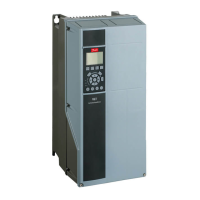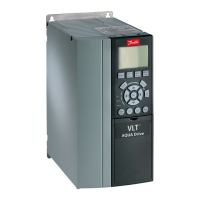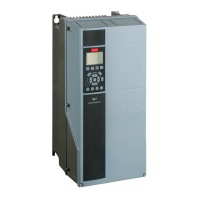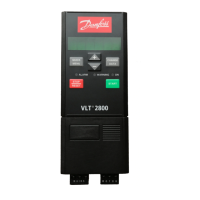VLT
®
8000 AQUA
Start-up conditions
In some applications, optimum setting of the process
regulator will mean that it takes an exces-sive time
for the required process state to be reached. In
such applications it might be an advantage to fix an
output frequency to which the frequency converter
is to bring the motor before the process regulator
is activated. This is done by programming a PID
start-up frequency in parameter 422.
D
ifferentiator gain limit
If there are very quick variations in a given application
with respect to the reference/setpoint signal or the
feedback signal, the deviation between reference/
setpoint and the actual process state will quickly
change. The differentiator may thus become too
dominant. This is because it reacts to the deviation
between the reference/setpoint and the actual
process state. The quicker the deviation changes,
the stronger the resulting differentiator frequency
contribution. The differentiator frequency contribution
can thus be limited to allow the setting of a reasonable
differentiation time for slow changes and a suitable
frequency contribution for quick changes. This is done
in parameter 426, PID Differentiator gain limit.
L
owpass filter
If there are ripple currents/voltages on the feedback
signal, these can be dampened by means of a built-in
lowpass filter. Set a suitable lowpass filter time constant.
This time constant represents the limit frequency of
the ripples occurring on the feedback signal.
If the lowpass filter has been set to 0.1s, the limit
frequency will be 10 RAD/sec., corresponding to (10/
2xπ ) = 1.6 Hz. This means that all currents/voltages
that vary by more than 1.6 oscillations per second
will be removed by the filter.
In other words, regulation will only be carried out
on a feedback signal that varies by a frequency of
lessthan1.6Hz.Chooseasuitabletimeconstant
in parameter 427, PID Lowpass filter time.
O
ptimisation of the process regulator
The basic settings have now been made; all that
remains to be done is to optimize the proportional
gain, the integration time and the differentiation time
(parameters 423, 424 and 425). In most processes, this
canbedonebyfollowingtheguidelinesgivenbelow.
1. Start the motor.
2. Set parameter 423 PID proportional gain to 0.3
and increase it until the process shows that the
feedback signal is unstable. Then reduce the
value until the feedback signal has stabilised. Now
lower the proportional gain by 40-60%.
3. Set parameter 424 PID integration time to 20 s
and reduce the value until the process shows
that the feedback signal is unstable. Increase the
integration time until the feedback signal stabilizes,
followed by an increase of 15-50%.
4. Parameter 425 PID differentiation time is only
used in very fast-acting systems. The typical
value is 1/4 of the value set in parameter 424 PID
Integration time. The differentiator should only be
used when the setting of the proportional gain and
the integration time have been fully optimized.
NB!:
If necessary, start/stop can be activated
a number of times in order to provoke an
unstable feedback signal.
✭
= factory setting. () = display text [] = value for use in communication via serial communication port
MG.83.A2.02 - VLT is a registered Danfoss trademark
138
